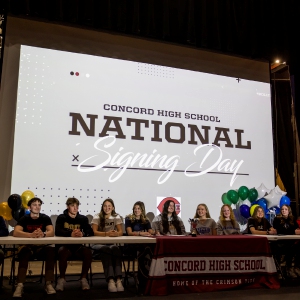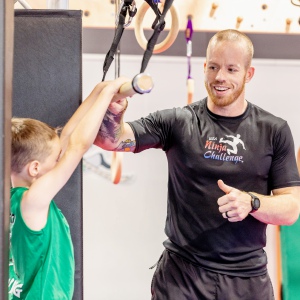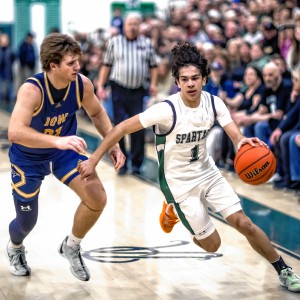Limited options for athletes seeking for scholarships in N.H.
| Published: 06-30-2016 11:34 PM |
Concord’s Andrew Lauderdale didn’t even think of playing football in college until his junior year at Trinity High School in Manchester. Then, the summer before his senior year, Lauderdale went to a football camp at Boston College, where he was seen by dozens of college coaches. And just like that, college football evolved from a vague notion into a possibility that would become a reality.
“I kind of wanted to go out of state ... go to a big school,” said Lauderdale, who started at right tackle last year for the University of New Hampshire and is expected to be the starting left tackle as a fifth-year senior this fall. “UNH gave me the opportunity to play there, and I took it.”
However, there are limited opportunities for high school students seeking athletic scholarships at New Hampshire colleges. Just four schools in the state offer athletic scholarships, and only one school, UNH, offers scholarships to compete at the Division I level.
Two institutions in the state have D-I athletic programs: Dartmouth and the University of New Hampshire. But Dartmouth is a member of the Ivy League, a D-I conference whose members do not offer athletic scholarships.
UNH offers six varsity sports for men and 10 for women, all of which offer full or partial scholarships to student athletes.
Among those 16 programs is the Wildcats football program, which plays in the Football Championship Subdivision, one of two subdivisions for D-I football. FCS schools are allowed to offer the equivalent of 63 full scholarships to their student athletes who play football, 22 fewer scholarships than programs that participate in the Football Bowl Subdivision, which includes big-name programs like Notre Dame, the University of Southern California and the University of Alabama.
More than half – 63 of 107 – of the available scholarships for male athletes at UNH are allotted to the football team, which as an FCS program, is classified as an “equivalency sport” by the NCAA, meaning the program can give partial scholarships to student-athletes and that the amount of total financial aid given to UNH football players must add up to, at most, the equivalent value of 63 full scholarships. Other equivalency sports at UNH include the men’s ice hockey program (18 scholarships), men’s soccer (8), baseball (9), and skiing (1). Men’s cross country and track and field, which are counted together for the purposes of NCAA regulations, have four scholarships.
The only men’s sport in New Hampshire where every scholarship recipient receives a full scholarship is UNH’s men’s basketball program, which can award up to 10 scholarships per year. Men’s basketball is designated by the NCAA as a “head count sport,” meaning that each student-athlete who receives financial aid counts as one of the 10 scholarships available.
Article continues after...
Yesterday's Most Read Articles
 ‘There was no oversight’: NH child advocate has been a watchdog for children's care. Now, the office is on the chopping block
‘There was no oversight’: NH child advocate has been a watchdog for children's care. Now, the office is on the chopping block
 Volunteer group wants to help homeless clean up their camp
Volunteer group wants to help homeless clean up their camp
 ‘Less finger pointing, more communication’: Longtime Chichester residents share hopes before second town meeting
‘Less finger pointing, more communication’: Longtime Chichester residents share hopes before second town meeting
 Casella Waste Systems’ landfill project in New Hampshire’s North Country denied permit
Casella Waste Systems’ landfill project in New Hampshire’s North Country denied permit
 New Healthy Buffalo owner to build market in Chichester
New Healthy Buffalo owner to build market in Chichester
 ‘It’s everything’: In largest rally yet, Trump protestors descend on Concord
‘It’s everything’: In largest rally yet, Trump protestors descend on Concord
Similarly, women’s basketball (with a maximum of 15 scholarships allowed by the NCAA), volleyball (12), and gymnastics (12) are also designated as head count sports.
In all, there are 39 scholarships available for female athletes in head count sports at UNH, and 13 scholarships for men’s basketball. Those three women’s teams – basketball, volleyball and gymnastics – had 14, 18, and 22 athletes, respectively, listed on their rosters during the 2015 school year, meaning that six volleyball players and 10 gymnasts were getting no scholarship aid.
So, how much education will an athletic scholarship pay for?
All told, there are 94 men’s athletic scholarships and 84 women’s athletic scholarships to be doled out in “equivalency sports” at UNH, which offers less than the maximum number of scholarships allowed by the NCAA in men’s soccer (8 scholarships awarded at UNH, 9.9 are allowed by the NCAA) , men’s skiing (1 scholarships at UNH, 6.3 allowed), men’s cross country/track and field (four scholarships at UNH, 12.6 allowed), women’s cross country/track and field (14 scholarships at UNH, 18 allowed) women’s swimming and diving (eight scholarships at UNH, 14 allowed), and women’s lacrosse (11 scholarships at UNH, 12 allowed).
According to scholarshipstats.com, the average amount of athletic scholarship aid to male athletes at UNH during the 2013-14 school year (the last year for which the site has data) was $16,606, while female athletes received an average of $17,380.
Michelle Bronner, the senior associate athletic director for compliance and student services/senior woman administrator at UNH, told the Monitor via email that about 140 UNH students are on full athletic scholarships and that the amount of financial aid received by students on athletic scholarships at UNH “fluctuates some year to year, but the average is around $26,000 a year.”
For an in-state student at UNH, the average scholarship amount will go much further than it would for an out-of-state student, as in-state tuition, fees, room and board at UNH is expected to be $28,562 for New Hampshire residents – compared to $42,362 for out-of-state students.
Three other New Hampshire schools – Franklin Pierce University, Southern New Hampshire University and Saint Anselm College – offer scholarships to student-athletes in their Division II programs.
According to the NCAA’s website, D-II programs operate under a “partial-scholarship model for financial aid in which most student-athletes’ college experiences are funded through a mix of athletics scholarships, academic aid, need-based grants and/or employment earnings.” All D-II programs are considered equivalency sports, where schools can dole out partial scholarships to as few or as many athletes as they’d like, provided they stay under the limits created by the NCAA.
Between SNHU, Franklin Pierce and Saint Anselm there are a total of 273.9 scholarships allowed under NCAA rules for men’s sports and 285.1 for women’s sports.
The average amount of scholarship aid awarded to athletes at those three private colleges, however, is significantly less than the cost of attendance. The annual tuition and room-and-board costs in excess of $40,000 per year at SNHU, according to the school’s website, while the average male athletic scholarship was worth $6,882 for the 2013-14 school year, according to scholarshipstats.com, while the average female scholarship was $12,213.
In Rindge, the total cost of attendance at Franklin Pierce is $46,850, according to the school’s website. The average athletic scholarships for male athletes ($3,215) and female athletes ($4,595) will cover less than 10 per cent of that bill.
At Saint Anselm, one year of attendance will cost $52,560 according to the school’s website, and the average athletic scholarship will cover around 10 percent of that – $4,128 for males, $5,440 for females, scholarshipstats.com says.
The athletic departments at Saint Anselm and SNHU both declined to clarify how many scholarships were in each sport, the average amount of financial aid for each scholarship athlete, or how many student-athletes, if any, are on full athletic scholarships. Multiple requests to the Franklin Pierce athletic department went unanswered.
Saint Anselm, however, doesn’t plan to stay in D-II much longer. Earlier this year, the Catholic liberal arts college announced that it is seeking to reclassify its athletic programs into Division III, which does not allow schools to provide athletic scholarships.
According to a document on Saint Anselm’s athletics website, the 2016-17 class would be the first class recruited under D-III rules, meaning that no athlete in that class would get scholarship aid for athletics. In 2017-18, the Hawks wwill begin playing in a D-III conference, though they would be ineligible for postseason play, and all athletic scholarship aid would be transitioned to other forms of institutional aid. By the 2021-22 school year, the school would become a full member of D-III.
Saint Anselm Athletic Director Daron Montgomery declined an interview request for this story.
Lauderdale said playing at UNH and being close to home is nice. He said that students who want a scholarship should spend more time in the weight room, as physical strength was one of the knocks against him during the recruiting process.
But Lauderdale said raising the level of performance on the field shouldn’t be the only focus for those aspiring to get an athletic scholarship.
“Grades. That also held me back,” Lauderdale said. “I wasn’t a terrible student ... but most coaches are looking for a 3.0 (GPA) or higher.”
Franklin’s Derrick Sylvester didn’t have to worry about grades during his college recruiting process. The 2008 graduate was the class valedictorian, and a 6-foot-6 pitcher with a fastball in the 90s and pinpoint control.
Sylvester received an athletic scholarship from Boston College and attended the D-I school for one semester before returning to his home state to pitch at SNHU.
“BC just didn’t work out for me at that time,” Sylvester said. “The overall feel that I had there didn’t fit my personality at the time.”
Sylvester said playing at Boston College turned playing baseball into, “too much of a job, too quick,” and though he knew he wanted to play professionally, he wasn’t ready for that workday feeling at the ballpark just yet. Looking for a less political and intense atmosphere, as well as one where he could better focus on his heavy academic load as a biology/pre-med major, Sylvester transferred to SNHU to finish his college career.
The transfer didn’t hurt his baseball career, either. Sylvester, who went 20-7 in 36 starts with 231 strikeouts over four seasons, was picked in the 34th round of the 2014 MLB draft by the Los Angeles Dodgers. He’s now in his third season with the organization.
“I got as good as I could playing (at SNHU), and I was still able to do everything I wanted to do,” Sylvester said.
Looking back, Sylvester said it’s up to the individual student to decide what the right situation is and what division they’re best suited to play in.
“Some kids don’t excel in the classroom ... and some will be better at baseball coming out of school than I was,” Sylvester said. “It’s really on the individual.
“Just because it’s a Division I school, or because it’s a big-name school, or because it’s a school that your friends go to ... nothing should make you want to go there unless you really want to go there.”
]]>







 High school track previews: Concord looks to build off of record-breaking season
High school track previews: Concord looks to build off of record-breaking season 12 Concord student-athletes sign on to play at the collegiate level
12 Concord student-athletes sign on to play at the collegiate level Concord’s USA Ninja Challenge aligned with changes to Pentathlon before LA 2028 Olympics
Concord’s USA Ninja Challenge aligned with changes to Pentathlon before LA 2028 Olympics Monitor names winter 2024-25 Players of the Season
Monitor names winter 2024-25 Players of the Season
